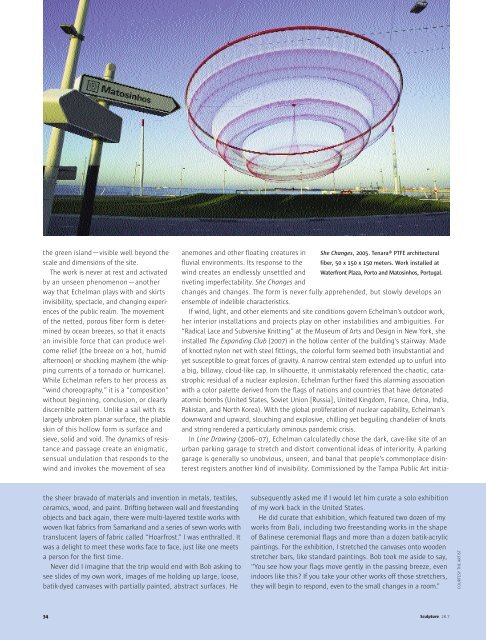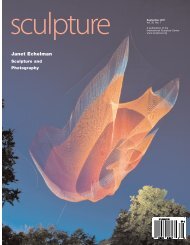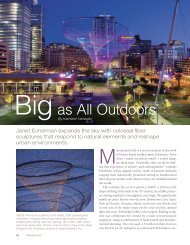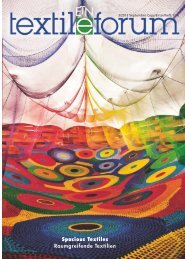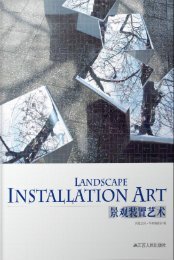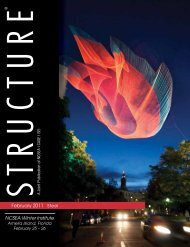Sculpture - Janet Echelman
Sculpture - Janet Echelman
Sculpture - Janet Echelman
Create successful ePaper yourself
Turn your PDF publications into a flip-book with our unique Google optimized e-Paper software.
the green island—visible well beyond the<br />
scale and dimensions of the site.<br />
The work is never at rest and activated<br />
by an unseen phenomenon—another<br />
way that <strong>Echelman</strong> plays with and skirts<br />
invisibility, spectacle, and changing experiences<br />
of the public realm. The movement<br />
of the netted, porous fiber form is determined<br />
by ocean breezes, so that it enacts<br />
an invisible force that can produce welcome<br />
relief (the breeze on a hot, humid<br />
afternoon) or shocking mayhem (the whipping<br />
currents of a tornado or hurricane).<br />
While <strong>Echelman</strong> refers to her process as<br />
“wind choreography,” it is a “composition”<br />
without beginning, conclusion, or clearly<br />
discernible pattern. Unlike a sail with its<br />
largely unbroken planar surface, the pliable<br />
skin of this hollow form is surface and<br />
sieve, solid and void. The dynamics of resistance<br />
and passage create an enigmatic,<br />
sensual undulation that responds to the<br />
wind and invokes the movement of sea<br />
anemones and other floating creatures in She Changes, 2005. Tenara® PTFE architectural<br />
fluvial environments. Its response to the fiber, 50 x 150 x 150 meters. Work installed at<br />
wind creates an endlessly unsettled and Waterfront Plaza, Porto and Matosinhos, Portugal.<br />
riveting imperfectability. She Changes and<br />
changes and changes. The form is never fully apprehended, but slowly develops an<br />
ensemble of indelible characteristics.<br />
If wind, light, and other elements and site conditions govern <strong>Echelman</strong>’s outdoor work,<br />
her interior installations and projects play on other instabilities and ambiguities. For<br />
“Radical Lace and Subversive Knitting” at the Museum of Arts and Design in New York, she<br />
installed The Expanding Club (2007) in the hollow center of the building’s stairway. Made<br />
of knotted nylon net with steel fittings, the colorful form seemed both insubstantial and<br />
yet susceptible to great forces of gravity. A narrow central stem extended up to unfurl into<br />
a big, billowy, cloud-like cap. In silhouette, it unmistakably referenced the chaotic, catastrophic<br />
residual of a nuclear explosion. <strong>Echelman</strong> further fixed this alarming association<br />
with a color palette derived from the flags of nations and countries that have detonated<br />
atomic bombs (United States, Soviet Union [Russia], United Kingdom, France, China, India,<br />
Pakistan, and North Korea). With the global proliferation of nuclear capability, <strong>Echelman</strong>’s<br />
downward and upward, slouching and explosive, chilling yet beguiling chandelier of knots<br />
and string rendered a particularly ominous pandemic crisis.<br />
In Line Drawing (2006–07), <strong>Echelman</strong> calculatedly chose the dark, cave-like site of an<br />
urban parking garage to stretch and distort conventional ideas of interiority. A parking<br />
garage is generally so unobvious, unseen, and banal that people’s commonplace disinterest<br />
registers another kind of invisibility. Commissioned by the Tampa Public Art initia-<br />
the sheer bravado of materials and invention in metals, textiles,<br />
ceramics, wood, and paint. Drifting between wall and freestanding<br />
objects and back again, there were multi-layered textile works with<br />
woven Ikat fabrics from Samarkand and a series of sewn works with<br />
translucent layers of fabric called “Hoarfrost.” I was enthralled. It<br />
was a delight to meet these works face to face, just like one meets<br />
a person for the first time.<br />
Never did I imagine that the trip would end with Bob asking to<br />
see slides of my own work, images of me holding up large, loose,<br />
batik-dyed canvases with partially painted, abstract surfaces. He<br />
subsequently asked me if I would let him curate a solo exhibition<br />
of my work back in the United States.<br />
He did curate that exhibition, which featured two dozen of my<br />
works from Bali, including two freestanding works in the shape<br />
of Balinese ceremonial flags and more than a dozen batik-acrylic<br />
paintings. For the exhibition, I stretched the canvases onto wooden<br />
stretcher bars, like standard paintings. Bob took me aside to say,<br />
“You see how your flags move gently in the passing breeze, even<br />
indoors like this? If you take your other works off those stretchers,<br />
they will begin to respond, even to the small changes in a room.”<br />
COURTESY THE ARTIST<br />
34 <strong>Sculpture</strong> 28.7


